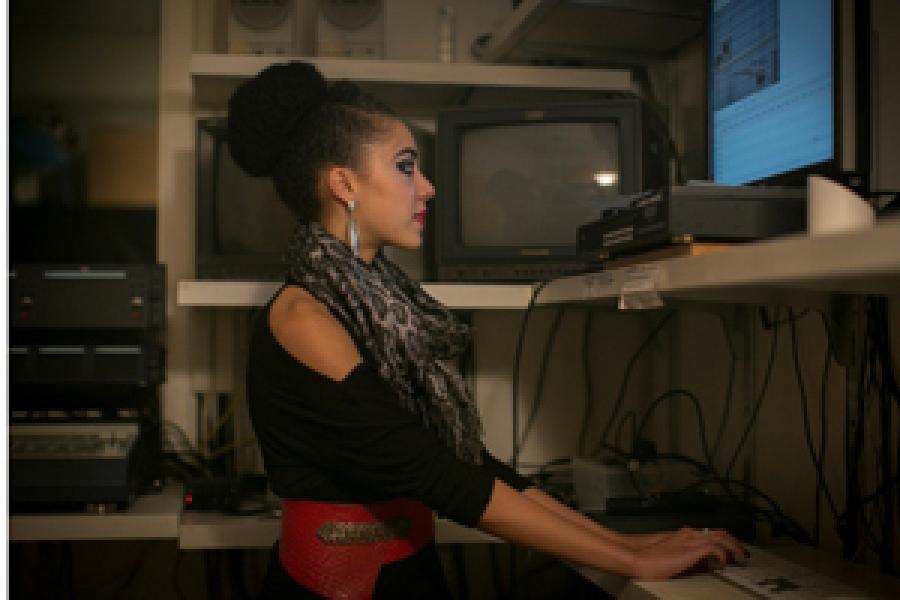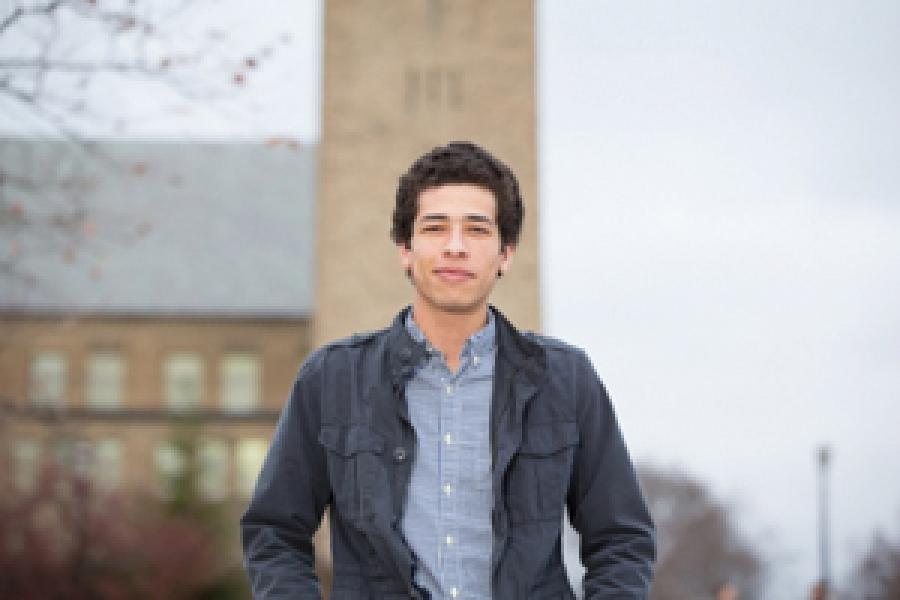As a pre-med student, Kasey Han ’18 knows the mental and physical benefits of a good workout. Han’s favorite workouts are a bit out of the ordinary, though, as they usually take place three stories up in the air.
Han has been a fan of circus arts since she tried out the flying trapeze as a middle-schooler during a family vacation. And she’s kept up her craft, now working out and teaching children at Circus Culture in downtown Ithaca.
Wanting a way to combine this passion with her studies, Han was recently admitted into the College Scholar Program in the College of Arts and Sciences. This innovative academic opportunity allows students to combine interest areas to create an interdisciplinary major focused on a particular area of research.
Han’s developmental circus arts research proposal will involve classes in biology, psychology and performing and media arts, among other departments.
“Circus arts help people to center their energy and attention on something,” Han said. “The growing field shows that Circus Arts holds a myriad of therapeutic benefits: fitness, coordination, trust, self-confidence, community and creativity.”
Han’s research will allow her to study both the social and health applications of circus arts. She plans to work with Circus Culture to create a student service club to bring circus arts to local people with disabilities and study its efficacy for her senior project. Further down the road, she imagines establishing a circus arts program at the hospital of her residency and hopes to see the day when circus arts becomes a widely-accepted therapy for treating various physical and emotional issues.
“I know there will be a lot of skeptics because this is a new and growing field,” she said. “Believing in developmental circus arts necessitates the same leap of faith that circus performers take every day.”
Anne Birien, advising dean in the College of Arts and Sciences and College Scholar program advisor, said this new group of 14 College Scholars is already cohesive and involved in a number of projects on campus and in the community.
“The individual projects the students proposed are very ambitious and already bear the mark of a sophisticated understanding of different academic disciplines,” she said, “as well as a good intuition about what each of those can be expected to contribute to their thinking.”
For Severine Hex ’18, the road to a College Scholar proposal began during her childhood in Idaho, where she spent most days outside, observing and communicating with animals that lived in the surrounding mountains.“I would wake up and eat and then I would be gone all day,” she said. “There weren’t fences; it was all woods. I would explore, make up stories and spend the days catching blue-bellied lizards. I learned how to perfectly imitate the sound of an elk calling to her baby when they were separated so I could summon elk.”
These experiences helped cement her strong beliefs that we as humans aren’t inherently different or “better than” animals, she said, leading her to a desire to help others connect on a deeper level to animals for conservation and protection.
Hex’s long-term dream is to open a research zoo at an institution like Cornell, where scientists, filmmakers and community members could study animals in-depth.
“Scientists could conduct research, but people could also come to see the animals,” said Hex, who worked at Zoo Boise during high school. “It would help them to appreciate not only the that the animal is cool-looking but that they have incredibly complex behaviors and forms of communication.”
Hex’s research will focus on animal communication; an area she said has been limited by a focus on animals having human-like communication.
“People expect that if animals have language it would be like human language, but I don’t see how that makes sense,” Hex said. “A lot of language research in non-human animals is looking for recursiveness, word recognition, the ability to use syntax — some of the many things assumed necessary for language. These studies test for human language, not the languages that these species may use naturalistically.”
Hex’s plan of study includes courses in the departments of neurobiology and behavior, psychology, computer science, sociology and philosophy, among others. She’ll be working with advisor Michael Goldstein, associate professor of psychology, in his Behavioral Analysis of Beginning Years lab, focusing on bird calls.
Conor Hodges ’18, another new College Scholar focusing on inequality studies, said his experience at Cornell helped him to reflect on his upbringing as the child of a single mom who worked selling jewelry to wealthy clients.“I started to critically engage with topics, wondering why we still fund certain programs with property taxes, what’s going on with the exploitative relationship between suburbs and urban spaces, about cultural capital and the role that plays in educational success for children, whether their parents feel comfortable going in and advocating for their child,” he said.
He found these topics fascinating for the role they played in his life, but didn’t find one particular major that would allow him to combine his interests. He’s charted a track of courses that would include the departments of government, history, philosophy, Africana Studies and the Center for Inequality Studies, among others.
He’s studied both governmental and non-governmental approaches that focus on inequality and poverty, as well as challenges to the welfare state such as Charles Murray and Richard Herrnstein’s “The Bell Curve.”
“I think the public perception of the deservedness of people at the bottom end of the socioeconomic spectrum is the most pressing issue in terms of addressing inequality,” Hodges said. “Especially in this country, there’s this perception that economic might makes right or that your success must inevitably and exclusively flow from your own hard work. It’s how you’re favored by this new sort of religion of the market that we have now.”
Hodges said he’d like to continue his education after Cornell so he can help address issues that he feels passionate about, which might include education or spatial and housing inequality.
“These sophomores have already identified intriguing and fruitful connections between their projects,” Birien said. “This isn’t surprising at all given how eager they were to find out about each other’s ideas even before we had our orientation briefing. It should be truly fascinating to follow this dynamic group as they choose to wrestle with some of the contemporary world’s most pressing and complex challenges.”
A version of this story also appeared in the Cornell Chronicle.







